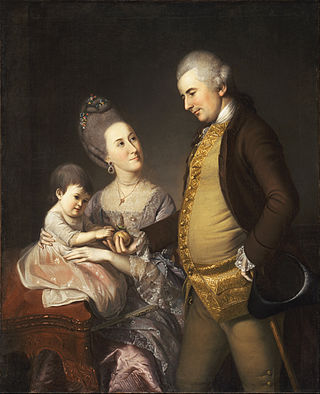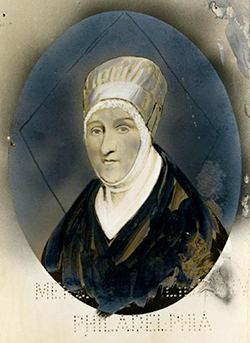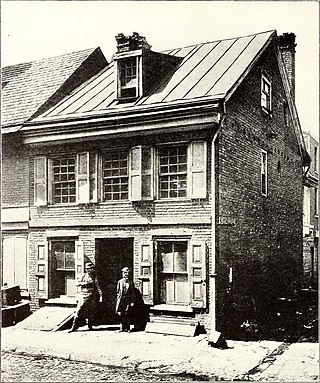
Benjamin Chew was a fifth-generation American, a Quaker-born legal scholar, prominent and successful Philadelphia lawyer, slaveowner, and chief justice of the Supreme Court of the Province of Pennsylvania and later the Commonwealth of Pennsylvania. Chew was known for precision and brevity in his legal arguments and his excellent memory, judgment, and knowledge of statutory law. His primary allegiance was to the supremacy of law and the constitution.

Germantown is an area in Northwest Philadelphia, Pennsylvania. Founded by Palatine, Quaker, and Mennonite families in 1683 as an independent borough, it was absorbed into Philadelphia in 1854. The area, which is about six miles northwest from the city center, now consists of two neighborhoods: 'Germantown' and 'East Germantown'.

Thomas Ustick Walter was an American architect of German descent, the dean of American architecture between the 1820 death of Benjamin Latrobe and the emergence of H.H. Richardson in the 1870s. He was the fourth Architect of the Capitol and responsible for adding the north (Senate) and south (House) wings and the central dome that is predominantly the current appearance of the U.S. Capitol building. Walter was one of the founders and second president of the American Institute of Architects. In 1839, he was elected as a member to the American Philosophical Society.
Thomas Godfrey was a glazier and self-taught mathematician and astronomer in the Pennsylvania Colony, who invented the octant in 1730. A similar octant was also independently invented about the same time by John Hadley in London with Hadley receiving the greater share of the credit for development.

Horace Trumbauer was a prominent American architect of the Gilded Age, known for designing residential manors for the wealthy. Later in his career he also designed hotels, office buildings, and much of the campus of Duke University.

The Slate Roof House was a mansion that stood on 2nd Street north of Walnut Street in Philadelphia, Pennsylvania, from about 1687 until its demolition in 1867. Built for Barbadian Quaker merchant Samuel Carpenter, the house occupied a small hill overlooking the Delaware River. It was built of brick]in the Jacobean style with its façade featuring two projecting wings that flanked a recessed central entrance. The house was notable for its large size as well for its slate roof, which was a rarity in early Philadelphia.

Thomas Affleck (1740–1795) was an 18th-century American cabinetmaker, who specialized in furniture in the Philadelphia Chippendale style.
Mantle Fielding, Jr. was an American architect, art historian, and tennis player.

Stenton, also known as the James Logan Home, was the country home of James Logan, the first Mayor of Philadelphia and Chief Justice of the Pennsylvania Supreme Court during the colonial-era governance of the Province of Pennsylvania. The home is located at 4601 North 18th Street in the Logan neighborhood of North Philadelphia.

The Wyck house, also known as the Haines house or Hans Millan house, is a historic mansion, museum, garden, and urban farm in the Germantown neighborhood of Philadelphia, Pennsylvania. It was recognized as a National Historic Landmark in 1971 for its well-preserved condition and its documentary records, which span nine generations of a single family.

The Arch Street Meeting House, at 320 Arch Street at the corner of 4th Street in the Old City neighborhood of Philadelphia, Pennsylvania, is a Meeting House of the Religious Society of Friends (Quakers). Built to reflect Friends' testimonies of simplicity and equality, this building is little changed after more than two centuries of continuous use.

Samuel Carpenter was a Deputy Governor of colonial Pennsylvania. He signed the historic document "The Declaration of Fealty, Christian Belief and Test" dated 10 September 1695; the original is in the Historical Society of Pennsylvania. Samuel was also called the "First Treasurer" of Pennsylvania, and was a partner and friend of proprietor William Penn.
Charles Gookin was a deputy governor of the Province of Pennsylvania.

The Hovenden House, Barn and Abolition Hall is a group of historic buildings which are located in Plymouth Meeting, Whitemarsh Township, Montgomery County, Pennsylvania. In the decades prior to the American Civil War, this property served as an important station on the Underground Railroad. Abolition Hall was built to be a meeting place for abolitionists, and later was the studio of artist Thomas Hovenden.

Deborah Norris Logan was an American Quaker historian and memoirist, and wife of politician George Logan.

Shawmont is a former train station in Philadelphia, Pennsylvania. It is located on Nixon Street in the Roxborough section of Lower Northwest Philadelphia. Built by the Philadelphia, Germantown and Norristown Railroad, it later became part of the Reading Railroad and ultimately SEPTA Regional Rail's R6 Norristown Line. SEPTA made the station a whistle stop and closed its waiting room in 1991. SEPTA later closed the station in 1996. In 2018, $1 million was set aside for repairs and rehabilitation.
The following is a list of works about Philadelphia, Pennsylvania, U.S.

Letitia Street House is a modest eighteenth-century house in West Fairmount Park, Philadelphia. It was built along the Delaware riverfront about 1713, and relocated to its current site in 1883. The house was once celebrated as the city residence of Pennsylvania's founder, William Penn (1644–1718); however, later historical research determined that he never lived there.
Friends meeting houses are places of worship for the Religious Society of Friends, or Quakers. A "meeting" is the equivalent of a church congregation, and a "meeting house" is the equivalent of a church building.
Reuben Haines III was a Quaker farmer, brewer, abolitionist, scientist, ornithologist, meteorologist, firefighter, philanthropist, and educational reformer from Philadelphia, Pennsylvania.
















